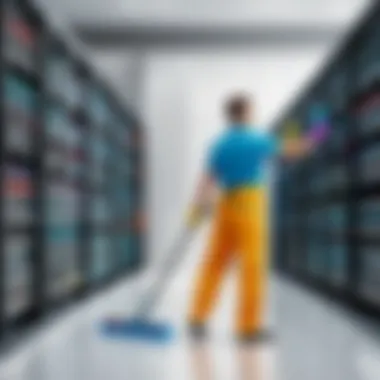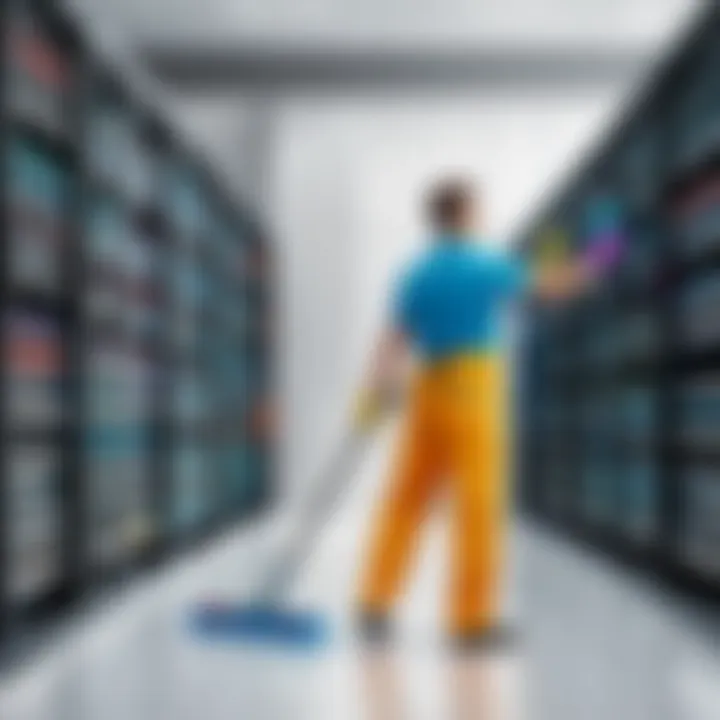Exploring Commercial Cleaning Management Software


Intro
In the modern cleaning industry, operational efficiency is paramount. As competition grows, businesses must find ways to stand out while providing excellent service. This is where commercial cleaning management software plays a critical role. This software helps streamline processes, enhance productivity, and improve service delivery. With various options available, understanding the key functionalities and benefits can guide businesses in choosing the right software solution.
Features Overview
Key Functionalities
The foundation of any effective commercial cleaning management software lies in its functionalities. These key features often include:
- Scheduling and Dispatching: Efficiently manage staff assignments and schedules, ensuring that the right personnel are available when and where they are needed.
- Client Management: Maintain detailed records of client interactions, preferences, and service history. This helps tailor services to individual needs.
- Monitoring and Reporting: Track performance metrics and generate reports to analyze operational efficiency, allowing businesses to make informed decisions.
- Inventory Management: Monitor cleaning supplies and other necessary materials, helping businesses maintain adequate stock levels and reduce waste.
- Invoicing and Payments: Automate billing processes, ensuring timely payments from clients and simplifying financial management.
These functionalities create a robust framework that enhances the day-to-day operations of cleaning businesses.
Integration Capabilities
Another vital aspect of commercial cleaning management software is its ability to integrate with other systems. This capability can significantly amplify efficiency by:
- Linking to Accounting Software: Many businesses rely on financial software like QuickBooks or Xero for bookkeeping. Integration minimizes data entry and reduces errors.
- Routing Tools: Integration with GPS or routing software can help optimize cleaning schedules and reduce travel time for staff.
- HR and Payroll Systems: Connecting with human resource tools enables more streamlined management of payroll, employee records, and performance tracking.
Seamless integration capabilities ensure that the software can adapt to the existing technology landscape of a business.
Pros and Cons
Evaluating commercial cleaning management software requires a look at its advantages and disadvantages.
Advantages
- Improved Efficiency: Automation of routine tasks frees up time for staff to focus on cleaning, ultimately driving productivity.
- Enhanced Communication: Real-time coordination between management and staff minimizes misunderstandings and improves service delivery.
- Data-Driven Decisions: In-depth reporting features allow businesses to utilize data for strategic planning.
Disadvantages
- Initial Costs: The initial investment can be high, particularly for small businesses. This might be a barrier to entry for some.
- Learning Curve: Employees may require training to effectively use the software, which can be time-consuming.
- Dependence on Technology: A system failure or technical issue can disrupt operations, so companies must have contingency plans.
"Choosing the right commercial cleaning management software can be a game-changer for your business. Its impact goes beyond operational efficiency—it can genuinely enhance customer satisfaction and business growth."
By weighing these pros and cons, businesses can make informed decisions that align with their strategic objectives.
Prelude to Commercial Cleaning Management Software
The commercial cleaning industry has evolved significantly in recent years. As competition increases and customer expectations rise, the need for efficient management practices becomes more apparent. This article focuses on the relevance of commercial cleaning management software, which serves as a vital tool. Understanding this software is crucial for any business looking to optimize its operations and improve service delivery.
Defining Commercial Cleaning Management Software
Commercial cleaning management software encompasses various applications designed specifically for the cleaning industry. These applications assist in streamlining operations, including scheduling, work orders, and client communications. Different types of software cater to a range of needs, from small cleaning companies to large organizations with multiple contracts. For instance, some software solutions might focus primarily on personnel management and scheduling, while others include built-in invoicing or performance metrics.
This software often integrates different functionalities to provide a comprehensive solution. It allows businesses to manage tasks centrally, reducing the chances of miscommunications and errors. In today's fast-paced environment, such tools are indispensable for maintaining a competitive edge.
Importance in the Cleaning Industry
In the cleaning industry, the efficiency of operations directly impacts profitability. Commercial cleaning management software assists in minimizing overhead costs while maximizing service quality. By automating mundane tasks, it allows management to focus on strategic decisions and customer relationships.
Several factors highlight the importance of this software:
- Improved Accountability: With tracking features, businesses can ensure that all tasks are completed on time and to the desired standard.
- Data Management: This software allows for better data collection and analysis, leading to informed decision-making regarding resource allocation and pricing strategies.
- Customer Retention: Happy clients are likely to return. The software helps maintain communication and transparency, which is essential for building trust.
In summary, the effective use of commercial cleaning management software can significantly improve operational efficiency, enhance customer service, and ultimately contribute to the long-term success of cleaning businesses.
"In a world dominated by technology, leveraging effective management software can be the defining factor between success and stagnation in the cleaning industry."
As we delve deeper into the sections of this guide, we will explore the specific features of these software solutions and their numerous benefits.
Key Features of Effective Software Solutions
The selection of commercial cleaning management software is crucial to the success of any cleaning business. Specific features within the software can significantly influence operational efficiency and customer satisfaction. This section will explore the essential features that effective software solutions should possess, emphasizing their importance in the cleaning industry.
Scheduling and Dispatching
One of the primary functions of effective cleaning management software is its scheduling and dispatching capabilities. An intuitive scheduling tool allows managers to allocate tasks easily and efficiently. This feature can help in drafting daily work orders, assigning crews, and tracking their progress in real time. Moreover, effective dispatching means better time management, ensuring that cleaners arrive on time at job sites, which enhances overall service quality.
Consider the impact of dynamic scheduling that adjusts to last-minute changes; for instance, if a client reschedules a cleaning appointment, the software should automatically adjust the cleaning crew's schedule. This flexibility is essential for maintaining client relationships. Also, mobile accessibility allows cleaners to receive updated schedules, which further streamlines communication between management and staff.
Work Order Management


Work order management within cleaning software is vital for streamlining operations and ensuring that tasks are completed efficiently. This feature enables the creation, tracking, and closure of work orders through a unified platform. It minimizes information silos that often occur within teams and ensures that everyone is aware of their responsibilities.
The ability to track the status of work orders allows managers to respond quickly to customer inquiries about project progress. Moreover, detailed work order records can provide insights for future projects and help in creating a stronger workflow across teams. An effective work order management system also reduces errors, which may lead to reduced operational costs.
Client Management
Client management tools are essential for building lasting relationships with customers. Effective software should allow businesses to manage client profiles, track communication history, and record preferences. The quality of these features can lead to personalized client service, making customers feel valued and understood.
In addition, effective client management helps in maintaining service history, which can help when renewing contracts or introducing new services. With the ability to segment clients and tailor marketing efforts, businesses can gain deeper insights into client needs. Implementing these features can translate to higher customer satisfaction and retention rates.
Reporting and Analytics
Reporting and analytics capabilities within cleaning management software provide actionable insights into business performance. This feature enables managers to generate customizable reports on various aspects such as client feedback, employee performance, and job completion rates. By analyzing this data, businesses can identify trends and areas for improvement.
Furthermore, the integration of analytics allows for data-driven decision-making. A business can track key performance indicators (KPIs) and benchmark progress towards set goals. For instance, if customer satisfaction rates decline, businesses can analyze relevant reports to understand underlying issues and adjust strategies accordingly.
"Data-driven decisions are key to operational success in the cleaning industry."
Benefits of Using Cleaning Management Software
Commercial cleaning management software is an essential tool for businesses in the cleaning industry. It offers a variety of benefits that not only streamline operations but also elevate service quality and customer satisfaction. The significance of using such software cannot be overstated. As operational demands increase, effective management becomes crucial. The right cleaning management software can address challenges and help companies optimize their performance.
Increased Operational Efficiency
One of the most substantial benefits of cleaning management software is increased operational efficiency. Businesses with effective software solutions can automate several key processes. From scheduling jobs to managing work orders, automation reduces the time and effort needed for routine tasks. This efficiency allows staff to focus on higher-level activities that require human intervention.
Moreover, the software provides features for real-time tracking of assignments and status updates. Companies can allocate resources more effectively and ensure that jobs are completed on time. By minimizing manual errors and improving task management, operational workflows become smoother. This results in not just faster service delivery, but also cost savings over the long term.
Enhanced Customer Satisfaction
Customer satisfaction is critical in the cleaning industry. Cleaning management software contributes to this by providing tools that enhance the client experience. When operations are managed effectively, clients benefit from timely communication, consistent quality of service, and responsiveness to their needs.
For instance, software solutions allow for easy reporting of issues and quick resolution. Cleaning companies can promptly address customer inquiries. A positive experience leads to loyalty and repeat business. When customers know they can rely on a service provider, it builds trust and strengthens relationships. Ultimately, this can lead to increased referrals and an improved reputation in a competitive market.
Real-Time Communication
In the cleaning industry, effective communication can make or break a project. Cleaning management software facilitates real-time communication between teams, supervisors, and clients. This ensures that everyone is on the same page regarding schedules, job progress, and any changes that may arise.
Instant messaging systems and notifications keep all stakeholders updated. For instance, if a job is delayed, the team can inform clients immediately. This transparency helps manage expectations and reduces potential frustration. Furthermore, mobile capabilities allow field staff to receive updates and provide feedback while on-site. Such connectivity enhances collaboration and overall productivity by creating a more cohesive working environment.
"Investing in cleaning management software not only improves operational metrics but also positively impacts client relationships."
In summary, the benefits of using cleaning management software are profound and far-reaching. They contribute to higher efficiency, better customer satisfaction, and improved communication, all of which are essential for maintaining a competitive edge in the cleaning industry.
Market Analysis of Commercial Cleaning Software
Understanding the market dynamics of commercial cleaning management software is crucial for businesses aiming to enhance their operations. Conducting a thorough market analysis not only illuminates the current landscape but also highlights potential areas for growth and improvement. This section focuses on identifying significant trends influencing the industry and recognizing who the main players are in the software market.
Current Trends Influencing the Industry
The commercial cleaning sector is experiencing notable shifts in technology and client expectations. As businesses seek efficiency and improved service delivery, the adoption of software solutions is becoming increasingly prevalent. Here are some trends that are shaping the market:
- Automation of Processes: Businesses are focusing on automating tasks like scheduling, invoicing, and reporting to increase efficiency and reduce human errors.
- Mobile Accessibility: With the rise of mobile technology, software providers are optimizing their platforms for mobile use. This allows cleaning personnel to access important information while on the go, improving communication and service delivery.
- Data-Driven Insights: Organizations are utilizing analytics to measure performance, track KPIs, and enhance decision-making. The demand for reporting capabilities within the software has risen significantly.
- Sustainability Focus: There is a growing emphasis on eco-friendly practices. Software solutions that help manage and track sustainability initiatives are becoming essential in the eyes of consumers.
These trends are fundamental for organizations looking to remain competitive. They indicate a shift in priorities within the cleaning industry, underscoring a need for adaptable and forward-thinking software solutions.
Key Players in the Software Market
The landscape of commercial cleaning software features various providers vying for market share. Their different offerings cater to specific needs within the industry. Recognizing these players helps businesses make informed decisions. Some of the notable names include:
- CleanTelligent: This platform provides tools for tracking service quality and managing customer feedback, which are essential for continuous improvement.
- JOBBER: Known for its user-friendly interface, JOBBER focuses on streamlining scheduling and dispatching while offering integrated invoicing.
- ServiceTitan: Catering to various service industries including cleaning, this software offers in-depth reporting and customer management features, vital for larger operations.
- ZenMaid: Designed specifically for the maid service industry, ZenMaid allows for easy scheduling and customer relationship management.
The competition among these players drives innovation and improvement in services offered. Understanding their strengths and weaknesses can empower businesses to choose the right software that meets their specific operational needs.
"A robust analysis of the market is indispensable for making strategic decisions, especially when it comes to investing in software solutions."
Integration with Existing Business Systems
Integrating commercial cleaning management software with existing business systems is crucial for maximizing effectiveness and enhancing operational efficiency. This integration ensures that various tools and platforms work together seamlessly, providing a unified framework for managing day-to-day operations.
When choosing a cleaning management software, one must consider how well it can connect with current systems, such as accounting software, customer relationship management, or human resources platforms. The right software can bridge any gaps in workflow, ensure accurate data flow, and minimize redundant tasks. Here are some key benefits and considerations regarding integration:
- Enhanced data accuracy: By syncing systems, you reduce the chances of data entry errors, as information is automatically updated across platforms.
- Streamlined communication: Integration facilitates real-time updates and notifications, which is particularly valuable for staff and clients.
- Improved resource management: An integrated system offers a comprehensive view of schedules, resources, and tasks, helping managers allocate resources more effectively.
However, the integration process is not without its challenges. Companies must pay attention to compatibility issues and the potential need for technical support. It may be necessary to upgrade certain systems or invest in custom APIs that allow disparate systems to communicate effectively.


Compounding Your Current Tools
Compounding your current tools refers to the strategy of incorporating new software solutions into the existing toolkit of a business rather than replacing everything. This approach reduces disruption while maximizing the value of current investments. For example, if a cleaning business already employs a project management tool or a client management system, finding cleaning management software that integrates with these tools can provide several advantages:
- Efficiency: Employees can continue to work in familiar environments, reducing the learning curve associated with new software.
- Cost-effectiveness: Maintaining existing tools may lower software acquisition costs and ongoing training expenses.
- Holistic view: Compounding ensures that you can access a comprehensive outlook on business operations, enhancing decision-making.
By carefully selecting software that complements your existing tools, businesses can maintain continuity and improve overall efficiency.
APIs and Third-Party Integrations
Application Programming Interfaces, or APIs, play a critical role in facilitating integrations between cleaning management software and other business systems. APIs are sets of rules that allow one piece of software to interact with another, helping users to leverage the full capabilities of both systems.
- Increased Flexibility: APIs provide the flexibility to integrate with various tools. This means that businesses can customize solutions for their unique needs by connecting to third-party applications or internal systems.
- Speed in Onboarding: Using pre-built APIs, businesses can quickly connect their software solutions without extensive coding or development.
Third-party integrations also open up a world of possibilities. These could range from financial applications like QuickBooks to project management solutions like Asana. Each integration adds specialized functionality that can help businesses operate more effectively and improve customer service.
In summary, seamless integration of cleaning management software with existing business systems amplifies operational effectiveness. The right integrations can lead to improved accountability, better resource utilization, and greater overall efficiency. Adopting a strategy that prioritizes integration with current tools and utilizes APIs effectively is crucial in enhancing business operations in the commercial cleaning industry.
Implementation Process of Cleaning Software
The implementation process of cleaning software can significantly influence how well a company adapts to this new tool. Selecting the right software for commercial cleaning is just the first step. The true challenge lies in the successful implementation, which encompasses several critical elements. A well-planned implementation process not only minimizes disruptions but also maximizes the benefits that the software can deliver.
A systematic approach to implementation includes understanding business needs, configuring the software, and preparing the staff. This stage is essential because it lays the foundation for how effectively the software will be used within the organization. Key benefits of a structured implementation include smoother transitions, lowered resistance from the team, and quicker realization of operational efficiency gains.
It is also crucial to consider potential challenges during the process. Recognizing these before they arise allows businesses to navigate them proactively. Each of these factors contributes extensively to the overall success of the software in enhancing work processes in a commercial cleaning environment.
Planning and Preparation
Planning and preparation are foundational steps in the implementation of cleaning software. Before any software is rolled out, businesses should conduct thorough research to understand their specific needs. Identifying what aspects of the cleaning operations require improvement will guide the implementation process.
An effective implementation strategy should include:
- Assessment of Current Operations: Understand current workflows and pinpoint areas that need optimization.
- Choosing the Right Solution: Evaluate different software options and select one that aligns with identified needs and goals.
- Setting Objectives: Define clear objectives to measure the software's success, such as increased task efficiency or enhanced reporting accuracy.
Preparing a detailed project plan can help in laying out all steps involved. The involvement of various stakeholders, including management and staff, is critical in creating buy-in, which can ease the transition later. High engagement from these groups can lead to tailored solutions that better fit the company's culture and workflow.
Training Staff for Effective Use
Training staff effectively is paramount for maximizing the benefits of any cleaning management software. Without proper training, even the most sophisticated software can become underutilized.
Training should encompass several key components:
- Hands-on Training Sessions: Provide interactive sessions where staff can familiarize themselves with the features and functionality of the software.
- User Manuals and Documentation: Distribute easy-to-follow guides that staff can refer to after initial training. This helps reinforce learning and assists in troubleshooting.
- Feedback Mechanism: Establish a method for staff to communicate difficulties or suggestions regarding software usage. Addressing these in real-time can lead to improvements in both user experience and software efficiency.
Ongoing support and updates are also vital. Softwares are updated frequently, and continuous training will ensure that staff remain proficient with new features. Engaging employees in the process will not only enhance their skills but will also bolster their confidence in utilizing the software to improve service delivery.
"Well-structured training is key to unlocking the full potential of cleaning management software."
Thus, a focused approach to staff training can pave the way for significant operational improvements and drive a higher level of customer satisfaction.
Evaluating Different Software Options
Choosing the right commercial cleaning management software is a decisive step for any business within the cleaning industry. This section aims to articulate the process of evaluating different software options, shedding light on specific elements that make the evaluation effective.
When assessing software solutions, companies should consider several critical factors. First, it is essential to identify which features align with the company’s specific needs. Key functionalities may include scheduling, client management, and real-time communication. Understanding how these features can enhance operational efficiency is crucial. Additionally, organizations should take into account the user interface, as an intuitive design facilitates ease of use across all levels of staff.
Another important aspect is scalability. As business demand fluctuates, the ability of the software to grow and adapt with the business needs is vital. Ensuring that the solution can manage increasing workloads without compromising performance can save future costs and headaches of switching to another system later.
In summary, evaluating software options encompasses analyzing essential features, considering usability, and ensuring scalability. Each element contributes to creating a seamless operation for commercial cleaning businesses.
Criteria for Selection
Selecting the right software involves criteria that must align with business requirements. Companies should begin by determining their fundamental needs. For instance, if most operations revolve around personnel management, a solution focusing on scheduling and team assignments may be ideal.
Furthermore, evaluating software based on the following criteria is advisable:
- Ease of Use: The software should have a user-friendly interface, minimizing the learning curve for employees.
- Customization Options: The ability to tailor the software according to specific business needs can greatly enhance its effectiveness.
- Integration Capabilities: Look for software that can easily integrate with existing systems, such as accounting or customer relationship management software.
- Customer Support: Reliable customer support can facilitate smoother adoption and ongoing use of the software.
- User Reviews and Feedback: Researching reviews from other users provides valuable insight into the software’s strengths and weaknesses.
Making informed decisions based on these selection criteria can lead to a more suitable and beneficial software choice for your cleaning business.
Cost-Benefit Analysis
Conducting a cost-benefit analysis is essential to understanding the financial implications involved in adopting new software. This analysis provides clarity on whether the investment is worthwhile given the prospective efficiencies gained.


In this context, the following factors should be evaluated:
- Initial Costs: Assess the purchase price, including any installation and setup fees.
- Operational Savings: Estimate potential savings through improved efficiency and reduced labor costs.
- Training Costs: Factor in the expense of training employees to use the new software effectively.
- Long-Term Benefits: Consider the enhancements in service delivery and customer satisfaction over time.
Considering these elements helps businesses to ascertain whether the software investment will yield a favorable return over its lifespan. A thorough cost-benefit analysis serves not just as a financial measurement but as a strategic tool for determining if the software will effectively meet future challenges.
Case Studies and Success Stories
In the realm of commercial cleaning management software, real-world applications can provide concrete evidence of effectiveness. Case studies and success stories highlight how various organizations have leveraged these software solutions to enhance their operations. They serve not only as testimonials but also as blueprints for how to implement similar strategies successfully. Such narratives help clarify specific elements like efficiency improvements, customer satisfaction rates, and operational costs.
The insights gleaned from these case studies can prove invaluable for both potential and existing users of commercial cleaning management software. These practical examples underline the adaptability and scalability of software solutions within the diverse cleaning industry landscape.
Real-world Examples of Implementation
One notable example is the case of CleanCo, a mid-sized cleaning services company based in California. Faced with disorganized schedules and communication lapses, they deployed Duzio Clean Manager. The software offered features like real-time scheduling, which significantly alleviated their dispatching troubles.
After implementing the system, CleanCo reported a 35% reduction in response time to client inquiries. They also observed a 25% increase in job completion rates, stemming from better job slot management. With the software’s reporting capabilities, management was able to track performance metrics, identifying areas for improvement effectively.
Another example involves Sparkle Janitorial Services. This company, active in New York, encountered challenges related to client management and invoicing errors. By integrating Janitorial Pro, they streamlined their invoicing processes, which facilitated prompt payments. As a result, Sparkle reported a 40% decrease in invoicing disputes within just three months.
These examples demonstrate that adapting to commercial cleaning management software can lead not just to immediate benefits but also long-term improvements in operational efficacy.
Lessons Learned and Best Practices
From these real-world implementations, several key lessons emerge. First, the necessity of proper training for staff cannot be overstated. CleanCo’s management found that ongoing support and training were crucial for the full adoption of Duzio Clean Manager. They organized frequent workshops to ensure all employees could utilize the software to its fullest potential.
Additionally, Sparkle Janitorial Services learned the importance of monitoring and evaluation. They established metrics to assess the software's impact on their business continually. This meant regularly reviewing performance data provided by Janitorial Pro and making necessary adjustments in real-time to enhance operational output.
Moreover, both companies realized that client feedback deserves genuine attention. Utilizing the reporting features of these software solutions helped them gather valuable insights on customer satisfaction. Implementing changes based on this feedback created a more responsive service.
In summary, examining case studies and best practices allows businesses to learn from their peers’ experiences. This knowledge can guide their transition to commercial cleaning management software, ultimately fostering better operational performance and enhanced client relations.
Challenges in Adoption and Use
Adopting commercial cleaning management software presents several challenges for organizations. Understanding these challenges is crucial as they influence how effectively a business can implement this software and leverage its benefits. Resistance from employees, technical difficulties, and concerns about costs are some of the barriers that companies may face.
Overcoming Resistance to Change
Resistance to change is often the most significant hurdle in adopting new software solutions. Many employees become accustomed to existing processes and tools. Shifting to new software can create unease among staff. They may fear that their jobs are at risk or may simply prefer the comfort of familiar systems.
To counter this resistance, organizations should involve employees from the beginning of the implementation process. Communicating the benefits of the new software clearly can greatly enhance buy-in. Hold training sessions that allow employees to familiarize themselves with the software before it goes live, which can ease anxiety and bolster confidence in the new system. Moreover, providing ongoing support and feedback channels will help address concerns as they arise.
Here are a few strategies to ease the transition:
- Transparent communication about changes and their impacts on daily tasks.
- Involvement of employees in the decision-making process to encourage ownership.
- Regular updates through emails or meetings to keep everyone informed about progress.
Technical Difficulties in Integration
Technical difficulties are another major concern in the adoption of commercial cleaning management software. The integration of a new system with existing tools can be complex. Data transfer, system compatibility, and potential downtime can pose challenges that may disrupt operations.
It is essential to conduct a thorough assessment of current systems prior to implementation. Understanding the architecture of existing tools will help in identifying possible integration issues. Working with software vendors to ensure API compatibility is important. Most modern solutions offer integration capabilities, but testing these integrations beforehand can prevent multiple issues during rollout.
A stepwise integration process can mitigate technical difficulties. Here are some best practices for successful integration:
- Conducting a needs assessment to determine critical features required from the new software.
- Engaging IT specialists to assist with integration processes and troubleshoot issues.
- Testing the software within a controlled environment before full implementation to identify and resolve problems.
"Successful adoption of cleaning management software relies heavily on addressing both resistance to change and technical hurdles that can impede integration."
In addressing these challenges, businesses can pave the way for a smoother transition to commercial cleaning management software. The aim is to not only adopt the software but to ensure that it enhances operational efficiency and service delivery. This attention to challenging aspects is essential for long-term success.
The Future of Commercial Cleaning Software
The future of commercial cleaning software holds significant potential for transformation in the industry. As businesses look to streamline operations and enhance service delivery, the importance of advanced software solutions becomes more pronounced. The integration of emerging technologies promises to redefine how cleaning services are managed, optimized, and assessed across various sectors.
Emerging Technologies and Innovations
Continuously evolving technologies like Artificial Intelligence (AI), Internet of Things (IoT), and cloud computing are at the forefront of this transformation.
- Artificial Intelligence: AI can analyze operational data and predict patterns in cleaning schedules, leading to optimized resource allocation and increased productivity.
- Internet of Things: IoT devices can monitor equipment and facilities in real-time, providing actionable insights that help prevent issues before they arise.
- Cloud Computing: This allows for scalable solutions and easy access to data anywhere, making management more agile and responsive.
As cleaning businesses adopt these technologies, they are likely to improve efficiency and customer satisfaction. The ability to gather and analyze large sets of data can inform strategies that lead to better outcomes in service delivery.
Predictions for Market Evolution
Looking ahead, several trends are expected to shape the future of commercial cleaning software:
- Increased Automation: More processes will be automated, reducing manual entry and minimizing human error. This includes automated scheduling and invoicing features.
- Focus on Sustainability: As environmental consciousness grows, software solutions will likely incorporate features that track and report on sustainability practices, assisting businesses in meeting eco-friendly standards.
- Enhanced Data Security: With the shift to cloud-based solutions, there will be a stronger emphasis on cybersecurity to protect sensitive client and operational data.
- Greater Customization: More tailored solutions will emerge, allowing businesses to select features specific to their unique needs.
"The integration of technology in the cleaning sector is no longer optional, but a necessity for remaining competitive in the market."
These anticipated changes indicate a focus on increased efficiency, sustainability, and security. Businesses that proactively embrace these advancements will likely gain a competitive edge, making them more capable of addressing the ever-evolving demands of the industry.







